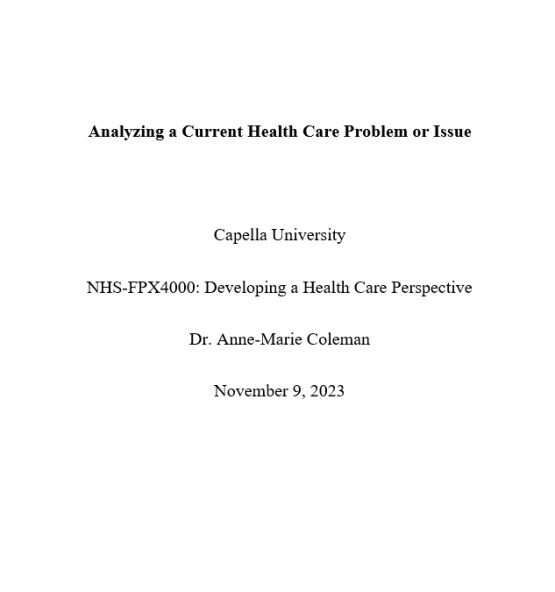


Analyzing a Current Health Care Problem or Issue
Capella University
NHS-FPX4000: Developing a Health Care Perspective
Dr. Anne-Marie Coleman
November 9, 2023
Availability:In Stock
Medication errors are preventable issues that expose an organization to adverse consequences such as increased risk of readmissions, prolonged hospitalization, and additional costs of care. Adverse drug reactions raise questions about the level of safety and commitment to enhancing a patient’s recovery from various conditions. Further, a facility risks losing credibility due to reputational losses associated with medication errors. In this context, healthcare leaders should initiate proactive solutions to enhance quality and safety of patient care across the continuum.
Medication errors are common in a critical setting where nurses and physicians handle complex situations. Such environments make individuals vulnerable to distractions, burnout, ineffective information flows, and others issues that jeopardize the quality of dispensing and administering medications (Alghamdi et al., 2019). The common causes of errors are dose miscalculations, incorrect diagnosis, prescribing errors, failed communication, and inadequate staff and patient education. The errors remind health leader and the care team about the need for proper procedures, processes, and systems. The goal is to address issues such as poor handwriting, missing information, wrong labeling and transmission of drug names, and prescription errors (Alrabadi et al., 2021). For this assessment, the focus is on wrong drug administration, which triggers an adverse drug reaction, severe complications, and premature deaths.
A case study on wrong drug administration involves a nurse’s negligence at Vanderbilt University Medical Center that led to a patient receiving a powerful paralyzer, vecuronium instead of the recommended sedative, versed (Clark, 2022). The nurse claimed that she accidentally confused the drugs leading to the unfortunate patient’s death. Investigations revealed that the nurse overrode instructions on drawing medication from an electronic cabinet. The process led to the nurse confusing the letters of drug names, hence selecting the wrong medication, administering, and causing a patient’s death.
Most medication errors are preventable since they largely reveal gaps in administrative, technical, and human-related safeguards. One cause of errors is nurse negligence, where one may ignore procedures, standards, and processes in place to enhance quality and safety of patient care (D’Errico et al., 2022). The neglect also entails distractions in unrelated tasks and conversations, failure to read instructions, and failure to consult in case of an issue. Secondly, weak supervision and oversight also increase the risk of wrong administration of high-risk medications (Alghamdi et al., 2019). Thus, wrong administration errors raise questions about robustness of policies, structures, and safety culture across the care continuum. The errors also show ethical concerns involving nurses’ non-adherence to the principles of non-maleficence, beneficence, and justice. Increased vigilance is necessary to reduce the risks of readmissions, prolonged hospitalization, deaths, and additional costs associated with adverse drug reactions.
Organizations have several options available to identify and intercept risks and errors across the care continuum. One strategy is creating barriers that enhance oversight and supervision when accessing high-risk medications. The solution prevents or delays access to sensitive drugs such as vecuronium (Clark, 2022). For instance, an obtrusive label clarifying a drug is paralytic helps prevent confusion when handling medications with similar initials. A second intervention is policies clarifying the importance of oversight and verification by a qualified practitioner before administering medications. The move ensures that patients received the right dosage and drug at the right timing.
A robust safety culture is importance to overcome normalization of mistakes and deviance that undermine a patient’s health and well-being (D’Errico et al., 2022). The right culture encourages nurses, physicians, and clinical assistants to find workarounds and provide timely updates on evidence-based interventions. Training and education is also necessary to remind the staff about the consequences of overriding safety measures during dispensation and administration of medications. Further, advancements in health technologies makes barcoding a necessary aspect of safety enhancement practices. The technology promotes accurate verification of medications, the patient, timing, dosage, and route. The goal is to ensure nurses adhere to the rights of medication administration across the care continuum.
Reviews
There are no reviews yet.